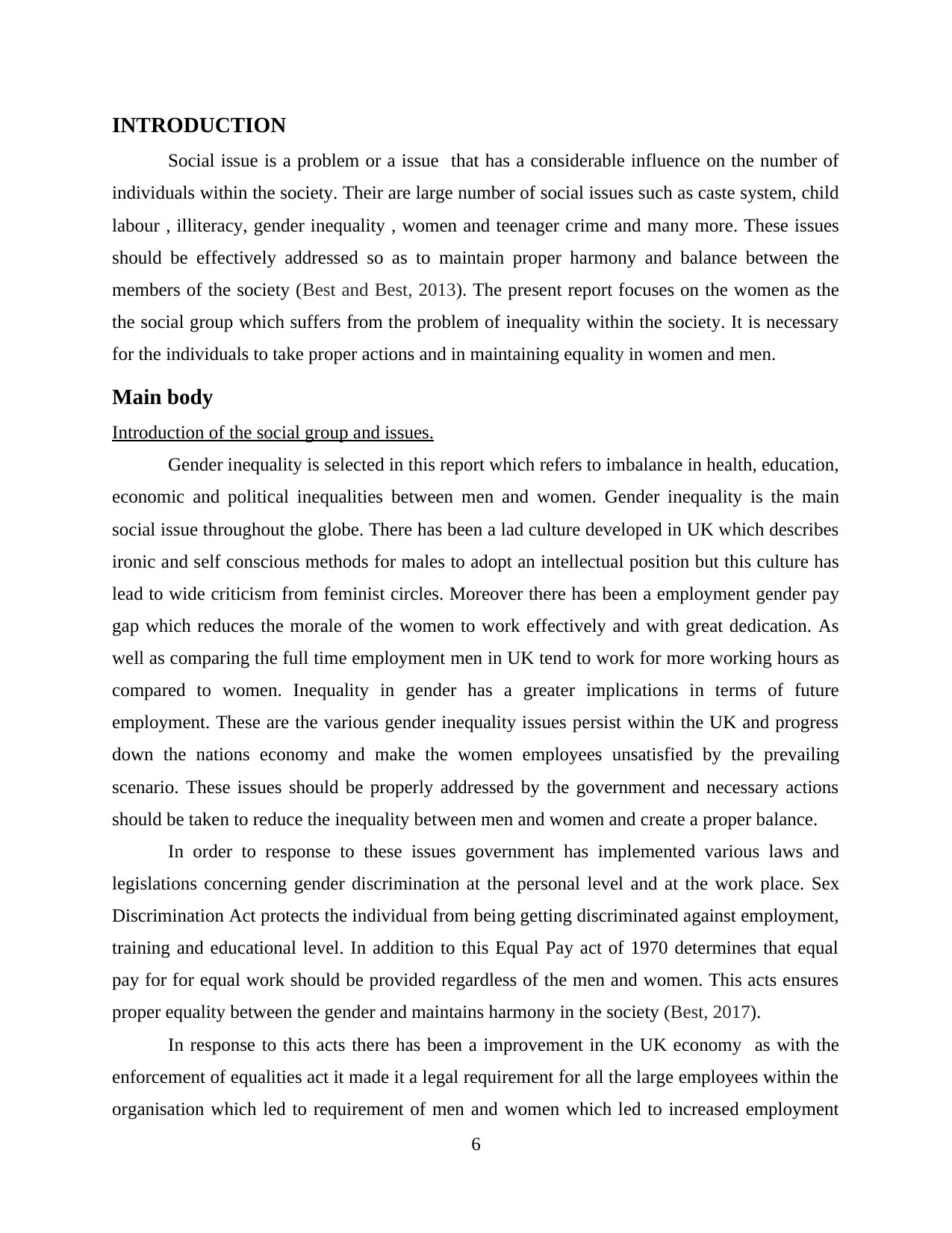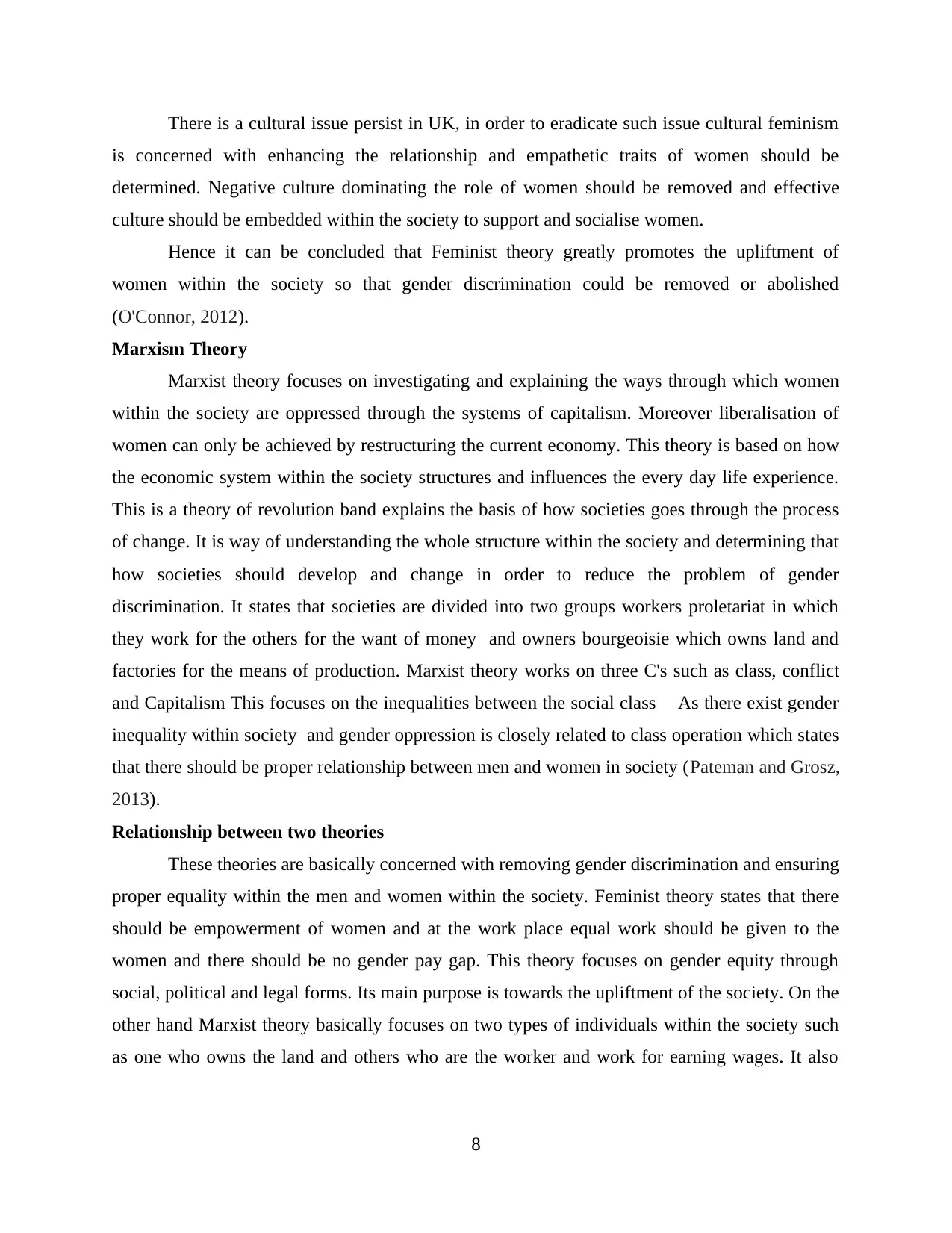Gender Inequality in UK: Sociological Analysis and Solutions Report
VerifiedAdded on 2020/11/23
|10
|1830
|412
Report
AI Summary
This report delves into the contemporary social issue of gender inequality, specifically focusing on the United Kingdom. It examines the various facets of gender inequality, including disparities in employment, wages, and cultural contexts, highlighting the impact on women's morale and national productivity. The report discusses relevant laws and legislation aimed at reducing gender discrimination and promoting equality, while also exploring the application of sociological and psychological theories, such as feminist and Marxist perspectives, to address and eradicate gender differences. The report analyzes the implications of gender inequality in the workplace, presenting statistical data and facts to underscore the existing challenges. Furthermore, it explores the influence of feminist and Marxist theories in understanding and addressing gender-related issues, offering insights into the historical and societal factors that contribute to gender disparities and the potential strategies for fostering a more equitable society. The report concludes by emphasizing the importance of continued efforts to eliminate gender inequality and promote equal opportunities for all members of society.

Contemporary Social
Issues PART 2
Issues PART 2
Paraphrase This Document
Need a fresh take? Get an instant paraphrase of this document with our AI Paraphraser


⊘ This is a preview!⊘
Do you want full access?
Subscribe today to unlock all pages.

Trusted by 1+ million students worldwide

Abstract
There are several social issues which are influencing the individuals within the society.
Gender inequality is the most social issue which is creating significant difference in the
employment, wage and other cultural issues which leads to reduced productivity and lowers the
morale of the women. There has been a high ratio of gender inequality in UK which a high
difference at the workplace and and affects the nations economy. Their are various laws and
legislation that should be imposed by the government to reduce gender discrimination and
promotes equality within men and women in the society. In addition to this use of effective
sociological and psychological theories helps eradicating the gender difference and promotes
equality within the society.
4
There are several social issues which are influencing the individuals within the society.
Gender inequality is the most social issue which is creating significant difference in the
employment, wage and other cultural issues which leads to reduced productivity and lowers the
morale of the women. There has been a high ratio of gender inequality in UK which a high
difference at the workplace and and affects the nations economy. Their are various laws and
legislation that should be imposed by the government to reduce gender discrimination and
promotes equality within men and women in the society. In addition to this use of effective
sociological and psychological theories helps eradicating the gender difference and promotes
equality within the society.
4
Paraphrase This Document
Need a fresh take? Get an instant paraphrase of this document with our AI Paraphraser

Table of Contents
.........................................................................................................................................................2
Abstract ...........................................................................................................................................3
INTRODUCTION...........................................................................................................................5
Main body........................................................................................................................................6
CONCLUSION................................................................................................................................9
5
.........................................................................................................................................................2
Abstract ...........................................................................................................................................3
INTRODUCTION...........................................................................................................................5
Main body........................................................................................................................................6
CONCLUSION................................................................................................................................9
5

INTRODUCTION
Social issue is a problem or a issue that has a considerable influence on the number of
individuals within the society. Their are large number of social issues such as caste system, child
labour , illiteracy, gender inequality , women and teenager crime and many more. These issues
should be effectively addressed so as to maintain proper harmony and balance between the
members of the society (Best and Best, 2013). The present report focuses on the women as the
the social group which suffers from the problem of inequality within the society. It is necessary
for the individuals to take proper actions and in maintaining equality in women and men.
Main body
Introduction of the social group and issues.
Gender inequality is selected in this report which refers to imbalance in health, education,
economic and political inequalities between men and women. Gender inequality is the main
social issue throughout the globe. There has been a lad culture developed in UK which describes
ironic and self conscious methods for males to adopt an intellectual position but this culture has
lead to wide criticism from feminist circles. Moreover there has been a employment gender pay
gap which reduces the morale of the women to work effectively and with great dedication. As
well as comparing the full time employment men in UK tend to work for more working hours as
compared to women. Inequality in gender has a greater implications in terms of future
employment. These are the various gender inequality issues persist within the UK and progress
down the nations economy and make the women employees unsatisfied by the prevailing
scenario. These issues should be properly addressed by the government and necessary actions
should be taken to reduce the inequality between men and women and create a proper balance.
In order to response to these issues government has implemented various laws and
legislations concerning gender discrimination at the personal level and at the work place. Sex
Discrimination Act protects the individual from being getting discriminated against employment,
training and educational level. In addition to this Equal Pay act of 1970 determines that equal
pay for for equal work should be provided regardless of the men and women. This acts ensures
proper equality between the gender and maintains harmony in the society (Best, 2017).
In response to this acts there has been a improvement in the UK economy as with the
enforcement of equalities act it made it a legal requirement for all the large employees within the
organisation which led to requirement of men and women which led to increased employment
6
Social issue is a problem or a issue that has a considerable influence on the number of
individuals within the society. Their are large number of social issues such as caste system, child
labour , illiteracy, gender inequality , women and teenager crime and many more. These issues
should be effectively addressed so as to maintain proper harmony and balance between the
members of the society (Best and Best, 2013). The present report focuses on the women as the
the social group which suffers from the problem of inequality within the society. It is necessary
for the individuals to take proper actions and in maintaining equality in women and men.
Main body
Introduction of the social group and issues.
Gender inequality is selected in this report which refers to imbalance in health, education,
economic and political inequalities between men and women. Gender inequality is the main
social issue throughout the globe. There has been a lad culture developed in UK which describes
ironic and self conscious methods for males to adopt an intellectual position but this culture has
lead to wide criticism from feminist circles. Moreover there has been a employment gender pay
gap which reduces the morale of the women to work effectively and with great dedication. As
well as comparing the full time employment men in UK tend to work for more working hours as
compared to women. Inequality in gender has a greater implications in terms of future
employment. These are the various gender inequality issues persist within the UK and progress
down the nations economy and make the women employees unsatisfied by the prevailing
scenario. These issues should be properly addressed by the government and necessary actions
should be taken to reduce the inequality between men and women and create a proper balance.
In order to response to these issues government has implemented various laws and
legislations concerning gender discrimination at the personal level and at the work place. Sex
Discrimination Act protects the individual from being getting discriminated against employment,
training and educational level. In addition to this Equal Pay act of 1970 determines that equal
pay for for equal work should be provided regardless of the men and women. This acts ensures
proper equality between the gender and maintains harmony in the society (Best, 2017).
In response to this acts there has been a improvement in the UK economy as with the
enforcement of equalities act it made it a legal requirement for all the large employees within the
organisation which led to requirement of men and women which led to increased employment
6
⊘ This is a preview!⊘
Do you want full access?
Subscribe today to unlock all pages.

Trusted by 1+ million students worldwide

opportunities for the men and women. There are some facts and figures which shows that
number of women has increased within UK. Female ration has increased to 69% at the junior
level post as compared to 31% for men. In addition to this 860,000 women run their own
companies in UK. It can be clearly analysed that there has been a significant improvement in the
removing the gender inequality and women started enjoying equal status and power within the
society (Gender Inequality in the Workplace. 2018.).
In order to support gender inequality and remove discrimination against men and women
this is supported by a Feminist Theory. It is a branch of sociological theory that focuses its
assumptions away from male view point and experience towards that of women. This theory
highlights on social problems, trends and the issues. It illuminates the forces which supports
inequality and injustice and promotes the way of providing justice and equality between the
gender.
Feminist theory focuses on the inequality between gender. It argues that women have the
same capacity as men to perform business work but due to the gender discrimination of
labour it has denied women opportunity to express their gratitude towards work.
Feminist theory also determines an understanding of how cultural factors and values
associated with women are different from men and they experience the social world
differently (Maclean, Harvey and Gordon, 2013).
Apart from this there are several major schools of thought such as the Liberal Feminism which
argues that men and women posses the same capacity to work and learn and equal opportunities
and treatment should be there so as to avoid gender inequalities. The main critique of this it
minimize gender differences and focused on equality. It fights for gender equality through social,
political and legal means. It believes that every individual has a importance in the society and
every women should enjoy equal rights as compared to men.
Other theory is the radical Feminism which states the dominance of males within the
society is the major focus of this theory. It explains that differences in women are emphasized
and separate women centred services should be promoted to uplift the women programme and
creates a drastic change within the society. This theory emphasises on women personal needs are
emphasized and their problems are concerned towards bringing upliftment of women within the
society.
7
number of women has increased within UK. Female ration has increased to 69% at the junior
level post as compared to 31% for men. In addition to this 860,000 women run their own
companies in UK. It can be clearly analysed that there has been a significant improvement in the
removing the gender inequality and women started enjoying equal status and power within the
society (Gender Inequality in the Workplace. 2018.).
In order to support gender inequality and remove discrimination against men and women
this is supported by a Feminist Theory. It is a branch of sociological theory that focuses its
assumptions away from male view point and experience towards that of women. This theory
highlights on social problems, trends and the issues. It illuminates the forces which supports
inequality and injustice and promotes the way of providing justice and equality between the
gender.
Feminist theory focuses on the inequality between gender. It argues that women have the
same capacity as men to perform business work but due to the gender discrimination of
labour it has denied women opportunity to express their gratitude towards work.
Feminist theory also determines an understanding of how cultural factors and values
associated with women are different from men and they experience the social world
differently (Maclean, Harvey and Gordon, 2013).
Apart from this there are several major schools of thought such as the Liberal Feminism which
argues that men and women posses the same capacity to work and learn and equal opportunities
and treatment should be there so as to avoid gender inequalities. The main critique of this it
minimize gender differences and focused on equality. It fights for gender equality through social,
political and legal means. It believes that every individual has a importance in the society and
every women should enjoy equal rights as compared to men.
Other theory is the radical Feminism which states the dominance of males within the
society is the major focus of this theory. It explains that differences in women are emphasized
and separate women centred services should be promoted to uplift the women programme and
creates a drastic change within the society. This theory emphasises on women personal needs are
emphasized and their problems are concerned towards bringing upliftment of women within the
society.
7
Paraphrase This Document
Need a fresh take? Get an instant paraphrase of this document with our AI Paraphraser

There is a cultural issue persist in UK, in order to eradicate such issue cultural feminism
is concerned with enhancing the relationship and empathetic traits of women should be
determined. Negative culture dominating the role of women should be removed and effective
culture should be embedded within the society to support and socialise women.
Hence it can be concluded that Feminist theory greatly promotes the upliftment of
women within the society so that gender discrimination could be removed or abolished
(O'Connor, 2012).
Marxism Theory
Marxist theory focuses on investigating and explaining the ways through which women
within the society are oppressed through the systems of capitalism. Moreover liberalisation of
women can only be achieved by restructuring the current economy. This theory is based on how
the economic system within the society structures and influences the every day life experience.
This is a theory of revolution band explains the basis of how societies goes through the process
of change. It is way of understanding the whole structure within the society and determining that
how societies should develop and change in order to reduce the problem of gender
discrimination. It states that societies are divided into two groups workers proletariat in which
they work for the others for the want of money and owners bourgeoisie which owns land and
factories for the means of production. Marxist theory works on three C's such as class, conflict
and Capitalism This focuses on the inequalities between the social class As there exist gender
inequality within society and gender oppression is closely related to class operation which states
that there should be proper relationship between men and women in society (Pateman and Grosz,
2013).
Relationship between two theories
These theories are basically concerned with removing gender discrimination and ensuring
proper equality within the men and women within the society. Feminist theory states that there
should be empowerment of women and at the work place equal work should be given to the
women and there should be no gender pay gap. This theory focuses on gender equity through
social, political and legal forms. Its main purpose is towards the upliftment of the society. On the
other hand Marxist theory basically focuses on two types of individuals within the society such
as one who owns the land and others who are the worker and work for earning wages. It also
8
is concerned with enhancing the relationship and empathetic traits of women should be
determined. Negative culture dominating the role of women should be removed and effective
culture should be embedded within the society to support and socialise women.
Hence it can be concluded that Feminist theory greatly promotes the upliftment of
women within the society so that gender discrimination could be removed or abolished
(O'Connor, 2012).
Marxism Theory
Marxist theory focuses on investigating and explaining the ways through which women
within the society are oppressed through the systems of capitalism. Moreover liberalisation of
women can only be achieved by restructuring the current economy. This theory is based on how
the economic system within the society structures and influences the every day life experience.
This is a theory of revolution band explains the basis of how societies goes through the process
of change. It is way of understanding the whole structure within the society and determining that
how societies should develop and change in order to reduce the problem of gender
discrimination. It states that societies are divided into two groups workers proletariat in which
they work for the others for the want of money and owners bourgeoisie which owns land and
factories for the means of production. Marxist theory works on three C's such as class, conflict
and Capitalism This focuses on the inequalities between the social class As there exist gender
inequality within society and gender oppression is closely related to class operation which states
that there should be proper relationship between men and women in society (Pateman and Grosz,
2013).
Relationship between two theories
These theories are basically concerned with removing gender discrimination and ensuring
proper equality within the men and women within the society. Feminist theory states that there
should be empowerment of women and at the work place equal work should be given to the
women and there should be no gender pay gap. This theory focuses on gender equity through
social, political and legal forms. Its main purpose is towards the upliftment of the society. On the
other hand Marxist theory basically focuses on two types of individuals within the society such
as one who owns the land and others who are the worker and work for earning wages. It also
8

reduces differences in the social classes and promotes equality between men and women gender.
These both theories aimed at promoting harmony between the members within the society.
Differences between two theories
There has been a significant difference in Feminism and Marxism theory where family
main purpose is to promote social upliftment of the women within the society and reduce
inequalities in men and women. It main issue to reduce unemployment problem, cultural issues
and to reduce pay gender gap. Moreover Marxism theory focuses on restructuring the current
economy and brings change in the structure of the society (Ridgeway, 2014)
CONCLUSION
From the above report it has been concluded that gender inequalities should be removed
within the society and equal treatment should be provided to the women's and men so that they
work productively by a way of enhancing nations economy. Various laws and legislations
should that are imposed by the government of UK helps in reducing the gender pay gap as well
as created various employment opportunities for women. Moreover effective use of Marxism and
Feminism theory should will assist in the upliftment of women's within the society.
9
These both theories aimed at promoting harmony between the members within the society.
Differences between two theories
There has been a significant difference in Feminism and Marxism theory where family
main purpose is to promote social upliftment of the women within the society and reduce
inequalities in men and women. It main issue to reduce unemployment problem, cultural issues
and to reduce pay gender gap. Moreover Marxism theory focuses on restructuring the current
economy and brings change in the structure of the society (Ridgeway, 2014)
CONCLUSION
From the above report it has been concluded that gender inequalities should be removed
within the society and equal treatment should be provided to the women's and men so that they
work productively by a way of enhancing nations economy. Various laws and legislations
should that are imposed by the government of UK helps in reducing the gender pay gap as well
as created various employment opportunities for women. Moreover effective use of Marxism and
Feminism theory should will assist in the upliftment of women's within the society.
9
⊘ This is a preview!⊘
Do you want full access?
Subscribe today to unlock all pages.

Trusted by 1+ million students worldwide

REFFERNCES
Books and Journals
Best, J. and Best, J., 2013. Social problems. New York: WW Norton & Company.
Best, J., 2017. Images of issues: Typifying contemporary social problems. Routledge.
Maclean, M., Harvey, C. and Gordon, J., 2013. Social innovation, social entrepreneurship and
the practice of contemporary entrepreneurial philanthropy. International Small Business
Journal. 31(7). pp.747-763.
O'Connor, C., 2012. Using social representations theory to examine lay explanation of
contemporary social crises: The case of Ireland's recession. Journal of Community &
Applied Social Psychology. 22(6). pp.453-469.
Pateman, C. and Grosz, E., 2013. Feminist challenges: Social and political theory. Routledge.
Ridgeway, C.L., 2014. Why status matters for inequality. American Sociological Review. 79(1),
pp.1-16.
Online
Gender Inequality in the Workplace. 2018. [Online]. Available Through:<https://www.market-
inspector.co.uk/blog/2015/10/gender-inequality-in-the-workplace>
10
Books and Journals
Best, J. and Best, J., 2013. Social problems. New York: WW Norton & Company.
Best, J., 2017. Images of issues: Typifying contemporary social problems. Routledge.
Maclean, M., Harvey, C. and Gordon, J., 2013. Social innovation, social entrepreneurship and
the practice of contemporary entrepreneurial philanthropy. International Small Business
Journal. 31(7). pp.747-763.
O'Connor, C., 2012. Using social representations theory to examine lay explanation of
contemporary social crises: The case of Ireland's recession. Journal of Community &
Applied Social Psychology. 22(6). pp.453-469.
Pateman, C. and Grosz, E., 2013. Feminist challenges: Social and political theory. Routledge.
Ridgeway, C.L., 2014. Why status matters for inequality. American Sociological Review. 79(1),
pp.1-16.
Online
Gender Inequality in the Workplace. 2018. [Online]. Available Through:<https://www.market-
inspector.co.uk/blog/2015/10/gender-inequality-in-the-workplace>
10
1 out of 10
Related Documents
Your All-in-One AI-Powered Toolkit for Academic Success.
+13062052269
info@desklib.com
Available 24*7 on WhatsApp / Email
![[object Object]](/_next/static/media/star-bottom.7253800d.svg)
Unlock your academic potential
Copyright © 2020–2025 A2Z Services. All Rights Reserved. Developed and managed by ZUCOL.





